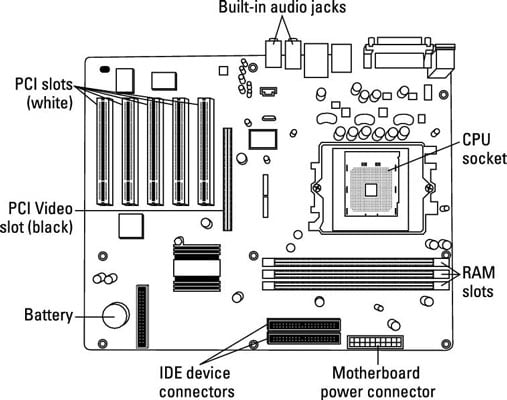PC Performance Upgrades: CPU, Motherboard, and Memory;- Performance upgrades give your PC an overall performance that affects all the programs you run, including Windows itself. Performance upgrades include those made to the CPU, motherboard, and memory.
CPU and motherboard upgrade
Simply put, the Central Processing Unit (CPU) is the primary brain of your computer. A major upgrade to your CPU usually results in more than simply replacing the CPU chip itself. For example, if you decide to upgrade from an older Intel Core 2 Duo processor to a quad-core Intel i7 3.4GHz CPU, your computer’s motherboard will almost certainly need to be replaced (as well as the RAM modules).
PC Performance Upgrades: CPU, Motherboard, and Memory
The motherboard is the largest circuit board in a computer case—it contains the CPU, memory units, and all of your other electronic devices—so this is probably one of the most technically demanding upgrades you can make.

Of course, replacing the computer brain with the next generation of chips leads to faster performance. The amount of speed depends on the chip’s speed — usually specified in megahertz (MHz) or gigahertz (GHz) — and whether you’re skipping a generation. This list describes two examples of promotion:
Core i5 3.0 GHz to Core i5 3.4 GHz: This upgrade increases speed. And since the generation of chips may remain the same, it is likely that you will be able to use your current motherboard. However, the performance increase may not be significant enough to be noticeable in many of your programs. (You don’t really make much progress.)
From a 2.2 GHz Celeron processor to the same Core i5 3.4 GHz: This upgrade, on the other hand, changes your plodding plow to Shadowfax (installation from Tolkien’s The Lord of the Rings). Not only are you installing a much faster CPU but you’re also upgrading from single-core Celeron technology to quad-core technology – and you’ll finish the tasks you do now in a fraction of the time.
Anything less is a waste of time and effort (unless the CPU drops a new chip on your pad for free).
Add memory to your computer
Adding memory (RAM or RAM) is a preferred performance upgrade. Here is the reason:
Memory packs a performance punch. Dollar for dollar, any PC technology will tell you more memory boosting performance is more important than simply upgrading your processor by a few megahertz. Windows uses every bit of that extra memory (bad technical pun intended there), and everything your PC does is faster.
Memory is cheap. Really really cheap. Most people can now afford the maximum capacity of their memory. (The total you can add depends on your motherboard, so check with your PC manufacturer or look up your motherboard specifications to determine the maximum amount of memory you can add.)
Memory is easy to install. Compared to upgrading your motherboard and CPU, adding memory is one of the simplest upgrade tasks you can perform in the guts of your device.
